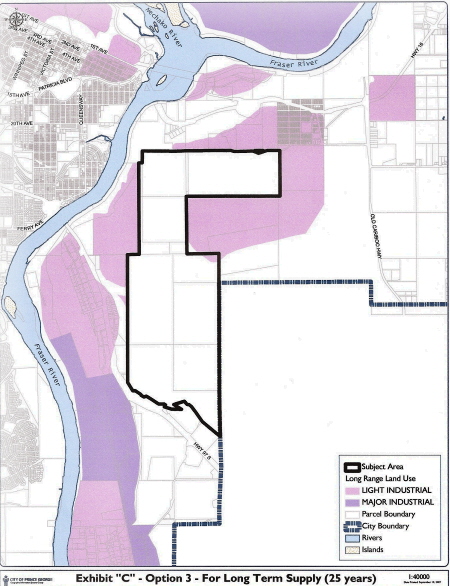Prince George Approves 25 Year Industrial Land Plan
By 250 News

The map shows the area identified for industrial development (courtesy City of Prince George)
Prince George, B.C. - The City of Prince George has adopted an industrial land strategy that would provide a long term plan for industrial development, but a great deal of the property is in the Agricultural Land Reserve.
The plan adopted was one of three presented to Council
Option 1 – Short Term – Consists of the existing undeveloped and unzoned land base west of the airport designated for light industrial development in the Official Community Plan.
Option 2 – Medium Term – This option involves the addition of 250 to 300 ha of land to the light industrial land base to meet anticipated demand over a medium term time frame. Medium term is in the 5 to 15 year time frame.
Option 3 – Long Term – Option 3 is to designate the required amount of land for light industrial development for a 25 year time horizon. This option would add approximately 710 ha of land for light industrial development, including the parcels currently under consideration for removal from the Agricultural Land Reserve. A total of 11 written submissions have been received. Although there is support for expansion of the light industrial land base in the area west of the airport, there were several concerns stated: There were several reasons Option 3 was the favoured option: Option 3 would add roughly 710 ha of land to the current 348 ha of land already designated for light industrial development west of the airport. Option 3 would provide for a large and cohesive land assembly which could be planned comprehensively.
The Agricultural Land Commission is currently considering an application to exclude approximately 685 ha of land within the area identified in Option 3.
Councillor Brian Skakun says it would be great to be able to tell potential developers there is land available "There is an appetite for industrial land and it would be great to be able to say there is a 20 acre lot available, or a five acre lot available or whatever. "
Councillor Debora Munoz is not in favour of setting aside ths much property and she says there are too many studies that are not yet complete, like the intermodal impact study , the air quality task force, the downtown transportation study, there is no dangerous goods route, there is no bylaw in place to deal with dangerous goods. "It is premature" says Munoz.
Mayor Colin Kinsley says he is in favour of this "I am excited because it's close to the airport, I'm excited because its not in the bowl, there's reasons for it in that entire area . That entire south east area I would like to see expansion and growth. I know we have to get some more services out to that area, but this kind of decision mught make that happen."
Councilor Munoz was the only member to oppose the approval of this item.
City staff will now proceed to prepare for public consultation.
Previous Story - Next Story
Return to Home









